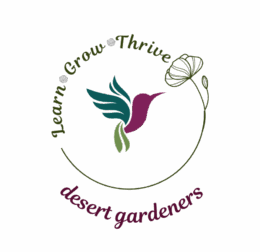At least in my area, some people still advise gardeners not to mulch their native desert plants. This article will explore some of the reasons why mulching is a good thing to do for your plants, and will discuss when not to do it.
First of all, let’s take a look at the two main types of mulch: organic and inorganic. Organic mulch is made from anything that was once alive and includes bark chips, leaves, sawdust, shredded paper, straw, cardboard, and the like. Inorganic mulch is basically ground up rock and is typically used in the form of gravel.
Certain native plants probably do better without organic mulch. These include palm trees and cacti and other succulents (such as yucca and agave). In nature, these plants are frequently found on rocky canyon walls or out in the sandy desert, and therefore do not generally have organic material around them. However, these plants can still benefit from gravel mulch. We’ll talk about why in a bit.
Pretty much most other plants native to the Sonoran Desert will benefit from some organic material around their roots. As I wrote in my article on desert soils, organic matter is hard to come by in most native desert soils. Organic matter helps the soil hold more moisture, can provide additional nutrients for plants, and also serves as habitat for soil microorganisms, all of which will have a very positive effect on your garden plants.
Even inorganic mulch has its good points. While it doesn’t provide many of the benefits of organic mulch, it does provide two key advantages which all mulch types convey: shading and protecting your soil. Shading soil means that the temperature of the top layer of soil doesn’t reach lethal temperatures in the heat of the day and also helps the soil hold in moisture. In winter, when deserts can have very cold temperatures, mulch will help insulate the soil and prevent plant roots from freezing and dying. Both gravel mulches and organic mulches also covers soil in a protective layer that helps reduce erosion from wind and rainstorms.
For these reasons, mulching your garden is a great idea. The more you mulch, the moister your soil will be, and it will undergo less temperature fluctuations. There are some potential disadvantages, however. The first is weeds: gravel in particular can create an environment for wind-blown weed seeds to colonize your yard. This can also happen with other types of mulch, particularly if it’s been sitting out in a pile somewhere, as this gives unwanted seeds the opportunity to take hold. I have had this problem in my yard with Bermuda grass, a very invasive non-native grass from Asia which is extremely difficult to eradicate.
However, this issue can be mitigated in large part through vigilance (looking for and removing unwanted intruder plants) and through carefully choosing your mulch material. When possible, I like to mulch with organic material from my own yard. When I get my larger shrubs and trees trimmed, my arborist spreads the choppings in my yard. He’s happy to do this because it saves him a trip to the landfill, and I get free mulch. I also use the leaves, catkins, and pollen from my mesquite trees as mulch; it falls from my huge mesquite tree onto my patio and I sweep it up and spread it around the non-paved areas of my yard.
There is one other important downside to covering your soil with mulch, and that is that it limits access to burrowing sites for various important insects, particularly ground-burrowing native bees which are facing huge population reductions due to loss of habitat. Arizona has around 1,300 native bee species, California has around 1,600, while New Mexico and Nevada have around 1,000. Most native bees around the world are solitary and about 70% of them nest in the ground.
If you’re planning to have a wildlife-friendly garden (which I hope you are since you’re reading my site), make sure you leave some large unmulched areas for bees to burrow in. They like sunny areas, and you can leave a few patches of 3 x 4 feet or so for them. If you want to give them additional help, provide a source of mud for them. This usually involves having a small source of water always present in your garden, and perhaps an area where it overflows onto bare soil to make a bit of mud.
I will write more in a future article on how you can help native bees. In the meantime, feel free to mulch most of your garden, and see the resources below to find out how you can help native bees.
Native Bee Resources
- Here are a couple of handy guides to native bees:
- Here’s a great guide on how to help native bees from the Arizona-Sonora Desert Museum.
- Here’s an article I wrote for the Arizona Daily Star about helping native bees.



